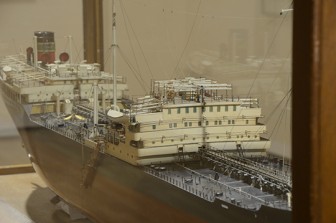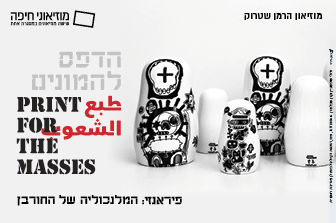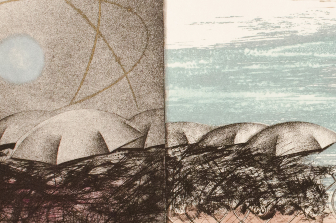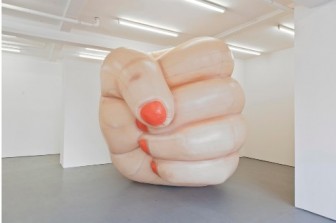Exhibitions
A Different Perspective on the Collection
Registrar’s Choice
The National Maritime Museum’s collection began nearly 70 years ago. Over the course of this time thousands of items have been collected, and it is always interesting to learn about a particular work’s history, such as how it came to be in the collection.
"Me, the Haifian"
In honor of the CZA's centennial, a number of exhibitions in museums throughout Israel will present materials kept in the archives. The Haifa City Museum has chosen to focus on the collection of Haifa posters and broadsides preserved in the archives. The collection affords an opportunity to learn about daily life in Haifa, about the different ideologies that characterized different periods in the life of the city, and about local graphic designers and printing houses.
"Print for the Masses" and "Piranesi: The Melancholy of Destruction"
Today print has become a diverse medium that combines traditional printmaking with new materials and production methods. Digital technologies, for example, have been swiftly integrated into the printmaking process, while traditional techniques have come to rely on photocopiers, fax machines, and inkjet printers. These new technologies have not made other methods obsolete, but rather have expanded the range of options and possibilities in the print medium.
"New Acquisition V"
This is the fifth exhibition of its kind at the Tikotin Museum since re-opening to the public in 1995. Once again, we are proud to present a broad spectrum of artworks donated to or acquired by the Museum during the years that have elapsed since “New Acquisitions VI” in 2014. Traditional and modern prints, clothing accessories and other items are included in this exhibition.
The Museum’s collection has been augmented in various ways over the years. We acquire modern and traditional Japanese works of art, mainly in genres that enrich and sustain the collection, and artworks from new fields as well. Artists exhibiting either solo or in group exhibitions donate their own works to the Museum. Furthermore, some Japanese artists who have yet to be exhibited at the Museum also donate works. The collection has also grown thanks to collectors’ gifts and donations.
"Poems Are More than Words"
In early ink drawings it was customary to include gasen (writing). Gasen is original prose or verse, or a quotation from classical literature or poetry. In some instances, the text is added by a friend or admirer of the artist, and in others by the artist himself. Beneath the text the signature and seal of the poet are added. During the Edo era (1603-1868), the long tradition of poem-paintings
also began to appear as ukiyo-e (pictures from the floating world),
the woodblock print genre. Although ukiyo-e is considered a
popular art form, it is still closely linked to the classical Japanese
culture. This is evident in the integration of classic tanka poems
in the paintings or prints. An innovation of the Edo period was
illustrating poetry anthologies. The best known of these is "One
Hundred Poems of One Hundred Poets" (Hyakunin isshu).
Women Make History
Feminism in the Age of Transnationalism
"Well-behaved women seldom make history," contended historian Laurel Thatcher Ulrich in 1976, and feminist discourse enthusiastically adopted this statement. From its beginnings feminism sought to liberate itself from binding social mechanisms, by means of groundbreaking practices meant to subvert a reality of silence and compliance and replace it with one of speech and protest.
Solidarity as a Means of Action
Group Exhibition
Much has been written on the subject of feminist solidarity, as a formative value that provides the political subject with a secure base from which to promote social struggles in various arenas. The concept of "solidarity," in its various meanings, has served in recent years as a framework for discussions in the feminist community. The call for solidarity is based upon the demand to dismantle supposedly competition in relations between women.
Fighting their Fate
Group Exhibition
This exhibition seeks to examine the symbolic representations of women in the context of oppressive power mechanisms in the contemporary global age. These representations are often considered in contemporary feminist thought, which seeks to change fundamental structures in the relations between the sexes. This contemporary feminist approach is based on a radical critique arguing that the man/woman dichotomy legitimizes the socio-political disempowerment of women.
This Sex Which is Not One*
Group Exhibition
The trans-feminist movement addresses feminist issues from a transgender perspective. Similarly to other third-generation feminist movements, trans-feminism often examines the effect of body image and the oppressive and destructive power of the binary gender conception.
The Blazing World*
Group Exhibition
When we try to imagine a world that is not based on Western gender conceptions we are in fact treading in the realm of science fiction; since we must imagine a society and a history entirely different from those we have known for centuries.











Please contact us and we will contact you as soon as possible